KUSHAL SETH and BRYANT CORMIER, Baker Hughes
As operators turn their attention back to liquid-rich plays, activity in the Permian basin aimed at opening more of the productive zones to the wellbore using horizontal drilling and hydraulic fracturing techniques has created a boom reminiscent of earlier eras in the petroleum industry. It’s also creating a familiar historical byproduct: multiple bbl of water for every bbl of oil produced.
While horizontal drilling and hydraulic fracturing generally increases production compared to vertical wells, often the water-to-oil ratio is dramatically higher, as well. The high water volumes are creating challenges for operators, including: infrastructure bottlenecks; logistical and safety issues related to truck traffic hauling freshwater to wellsites and produced water from wellsites to disposal wells; and sourcing of freshwater.
CHALLENGES OF MULTISTAGE FRACTURING
In addition to the logistical and potential safety challenges posed by the trucking activity, land owners are concerned about the wear and tear to their roads and are increasingly asking operators to look for ways to reduce the truck traffic.
Sourcing freshwater also is a concern. Multistage hydraulic fracturing often requires 30,000 to 100,000 or more bbl of freshwater per job. This tremendous demand for freshwater is expected to significantly influence freshwater supply and availability for future operations. Plus, when using such large volumes of freshwater, the cost and logistics of sourcing, transporting and storing the freshwater for hydraulic fracturing and other oilfield operations are a factor.
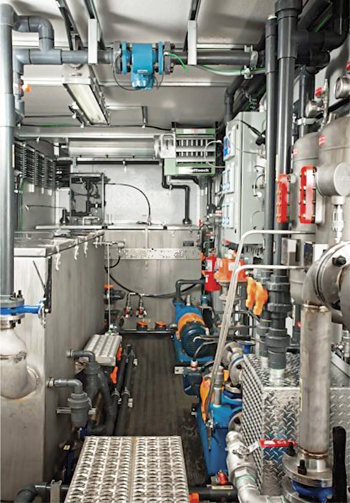 |
| Fig. 1. Internal view of H2prO HMS Plus system |
|
WATER ANALYSIS AND TREATMENT
Recently, an operator in the Permian Basin asked Baker Hughes to conduct a pilot project to test the technical and economic viability of reusing the produced and flowback water from its operations. The high volumes of produced water, the logistics and infrastructure bottlenecks, and the desire to reduce the consumption of freshwater for hydraulic fracturing operations, prompted the operator to explore alternative solutions to the traditional freshwater and disposal strategy.
After identifying core areas with high water cuts for the produced water treatment pilot program, Baker Hughes’ application engineers collected water samples from one tank battery to conduct laboratory analysis to determine the contaminants in the water. The pre-treatment water analysis indicated the water had highly variable levels of emulsified and free oil, suspended solids, iron, and a low pH level, but no hydrogen sulfide (H2S).
Multiple chemical, mechanical, and electrical technologies can treat wastewater, but oilfield wastewater treatment has its own challenges. The treatment methodology must be economically viable to treat the volumes of waste generated; it must be technically capable of removing the components that can negatively impact hydraulic fracturing fluid formulation, the wellbore, and the reservoir; and it also should be flexible enough to treat wastewater of inconsistent quality, which is almost always the case.
EC TECHNOLOGY TREATMENT
Based on the water analysis, the Baker Hughes H2prO HMS water management service, employing electrocoagulation (EC) technology was identified as the treatment option that best fit the operator’s application.
In the EC process, the coagulant is generated in situ through electrolytic oxidation of a proper anodic material. Electrocoagulation is a process that destabilizes suspended, emulsified or dissolved contaminants in a liquid by an introducing electrical current, which provides an electromotive force that causes chemical reactions. The destabilized particles aggregate into larger complexes. The process is effective because water contaminants, such as ions (heavy metals) and colloids (organic and inorganic) are primarily held in solution by electrical charges.
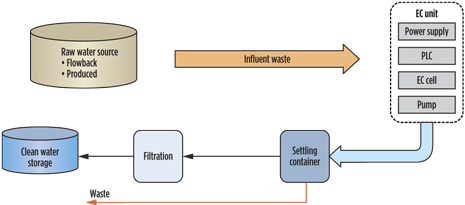 |
| Fig. 2. Conceptual flow diagram of EC treatment system |
|
Colloidal systems can be destabilized by the addition of ions of the charge opposite to that of the colloid. The destabilized colloids aggregate and can then be separated from the wastewater.
Several distinct electrochemical processes occur independently during the electrocoagulation process. These include seeding resulting from the anodic reduction of metal ions that become new centers for larger, stable, insoluble complexes; emulsion breaking resulting from oxygen and hydrogen ions reacting with emulsified substances and forming water insoluble material; halogen completing—as the metal ions bind themselves to halogens; bleaching by oxygen species produced in the reaction chamber and providing oxidation of chemical substances reducing biohazards through oxidation of bacteria and viruses; and electron flooding of the water, which impacts the polarity of water, allowing colloidal materials to precipitate.
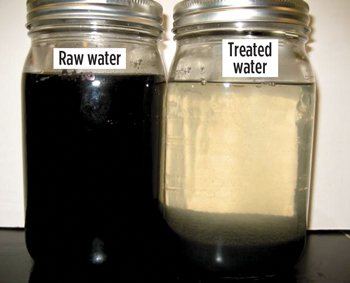 |
| Fig. 3. A visible difference between raw and treated water from a fracturing site. |
|
The EC process removes heavy metals and suspended solids that, if left untreated, can negatively impact the hydraulic fracture fluid formulation and the reservoir. EC technology does not require filters that quickly clog and must be changed frequently, resulting in added costs and nonproductive time (NPT).
Electrocoagulation also is more cost-effective compared to chemical clarification, which requires substantial chemical volumes and generates large amounts of sludge.
Advantages of EC include reducing suspended solids, colloids and emulsions without the use of chemicals; simple, flexible equipment operation; and lower sludge volume compared to other processes. Any sludge produced settles easily and can be dewatered. Another benefit is better separation efficiency due to the applied electric field, which sets the charged particles in faster motion for better coagulation.
One of the major disadvantages of the conventional EC process is formation of an impermeable oxide and scale layer on the electrodes. To overcome this challenge, Baker Hughes uses a patent-pending technology with a non-scaling electrodes.
This eliminates the need for chemical cleaning and grinding, and removes the risk of chemical exposure, which enhances the life of the system and reduces NPT during treatment. The proprietary sacrificial anode also allows for higher current densities without concern for scaling, which can cause higher concentrations of oxidants.
The EC treatment system is a ruggedized, mobile unit designed specifically for the oilfield. The units can be mobilized in as little as one hour of rig-up time and by treating water on-site, eliminates the costs and logistics of transportation and the hazards of transporting wastewater. A single treatment system can treat up to 8,500 bbl (1351 m3) of water per day and remove up to 99% of suspended solids and heavy metals, preventing potential formation damage when the water is reused in hydraulic fracture fluids. Iron levels are significantly reduced, enabling water reuse in cross-linked fracture fluid formulations.
The system also reduces hardness and levels of calcium, barium, strontium, and manganese up to 20% or more, helping limit scale formation.
APPLYING EC TREATMENT IN THE PERMIAN BASIN
The first water treatment job for the operator in the New Mexico portion of the Permian basin encountered some unexpected issues. An in-depth forensic analysis by Baker Hughes’ chemists and water management specialists showed that the source water composition was significantly different than the water collected and tested prior to the treatment.
Oil concentrations in the water were much higher than anticipated and H2S was present. It was determined that the pretreatment analysis tested water from only one tank battery, but the water that was to be treated on-site came from four different tank batteries.
When water from various wells and various tank batteries are commingled at varying rates, the water chemistry constantly changes. In addition, differing levels of metal corrosion byproducts from the storage facilities can have a significant impact on the water. Since Baker Hughes scientists analyze the water pre- and post-treatment both in the lab and in the field to fully understand the changing characteristics of water in each situation, the issue was quickly identified.
This in-depth chemical analysis of the water enabled Baker Hughes to recognize trends in the water composition and to make changes in the treatment process to address the variability in the water, to shorten the treatment cycle time, and to optimize costs.
In a typical EC process the treated water stream would need multiple hours prior to reuse to allow the flocculated solids to settle. In terms of footprint, that would mean having ten, 500-bbl tanks to hold the 5,000 bbl of treated water. This also would add significant cost to the operation. Baker Hughes tested and piloted a process that decreased the settling time by 95% while completely eliminating the need for any staging container.
The second and third water treatments conducted as part of the pilot project were performed at the wellsites one week prior to the scheduled hydraulic fracturing operation. The plan for the second job called for treating 5,000 bbl of water to use in one hydraulic fracturing stage. On the third project, 6,000 bbl of water was treated for use in one stage. Both these treatment jobs were conducted in areas specifically chosen to challenge the improved treatment process.
This operating area had large volumes of produced water with high iron content, emulsified and free oil, and suspended solids, as well as low pH levels. The operator recognized that if the water treatment process worked on this challenging water, it would be a viable solution in more benign environments.
Under the new treatment design protocol for the second and third treatment programs, prior to the water entering the electrocoagulation unit, Baker Hughes used the knowledge gained on the water chemistry and shifted the reaction equilibrium to the forward direction by adding additional hydroxyl ions. This, in turn, produced more coagulating agents during the electrochemical process, thus aiding in efficient and faster separation and settling.
The raw water entered the reaction cell from the bottom. As the water moved upwards in the cell, it was treated between the two electrodes. The treated water was sent to a low-energy thickening tank where the flocs were allowed to grow bigger and stronger.
As the flocs aggregated and became heavier, separation occurred. The water was filtered as a final polishing step. The treated, filtered water was sent to the holding tanks, where the treated water was used for the hydraulic fracturing operation. The inert solids were sent to a landfill for disposal.
In addition to testing the water to determine the most effective treatment process, extensive tests were conducted to ensure the water could be used to successfully design a borate cross-linked hydraulic fracturing fluid. The test criteria required an average bottomhole temperature of 146°F and pump times of approximately one hour. To test compatibility, additives and processes used in formulating conventional cross-linked systems were used in the tests.
Fluid viscosity measurements were performed using FANN 50 C viscometers configured with R1B5 rotor-bob. The rheological performance of the fluid, based on 100 sec-1 apparent viscosities, is shown in Fig. 4. The fluid was initially sheared at 100 sec-1 for 0.1 minutes, followed by a shear rate sweep of 100, 80, 60, and 40 sec-1 to calculate the power law indices, n′ and K′. The fluid was sheared at 100 sec-1 between shear rate sweeps, and the shear rate sweep was repeated every 15 minutes for the two-hour test.
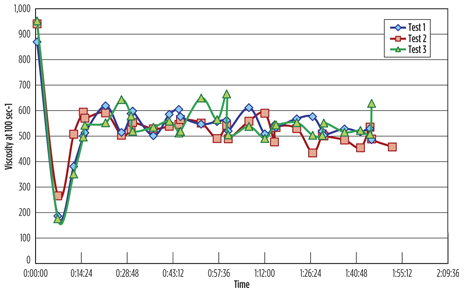 |
|
|
Rheology measurements at 146°F indicated that the fluid was thermally stable and had proper viscosity for proppant suspension and placement as required for the pump time. Even though this is fundamentally a borate cross-linked system, it had to be perfected and tailored for use with treated, high chloride, oil-laden wastewater. Modified fluid design helped in the development of a gelled fluid that kept a high enough viscosity throughout the duration of the stage and a cross-linked fluid stable enough to carry sand at its maximum concentration.
CONCLUSIONS
In addition to technical success, economic and environmental considerations are primary drivers when operators are considering treating produced and flowback water for reuse in hydraulic fracturing operations. Based on its experience in the Permian basin and other plays in the U.S., Baker Hughes has developed a model to compare scenarios with and without treatment as it relates to water management for hydraulic fracturing.
The economic impact of the treatment takes into account the costs associated with sourcing freshwater, transporting wastewater for disposal, renting hydraulic fracturing tanks for storage, and the technology for treating the water. Savings increase exponentially as the volume of water treated for hydraulic fracturing increases. The model is based on treating 25,000 bbl. As presented in Fig. 5, projections indicated a 20% cost savings was achieved by treating the water versus sourcing freshwater and disposing of produced water.
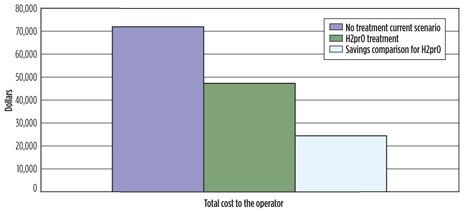 |
| Fig. 5. An operator can save $25,000/job by utilizing the H2prO system |
|
Of course, economics is just one driver. Operators also are pursuing ways to reduce the impact of operations to landowners and the general public.
To show the environmental impacts of on-site treatment, a comparison of the impact of trucking is presented in Fig. 6. Applying EC technology reduced the waste and trucking for the water volume treated by about 98%. In addition to the economic impact, this means less wear and tear on the roads and a lower carbon footprint. Reducing trucking requirements is just one of the environmental benefits of reusing produced and flowback water. Conserving freshwater resources also is a significant advantage of this strategy.
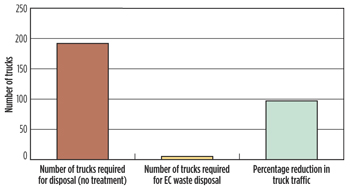 |
| Fig. 6. By reusing produced and flowback water in hydraulic fracturing operations, oil companies can reduce trucking requirements by as much as 98%. |
|
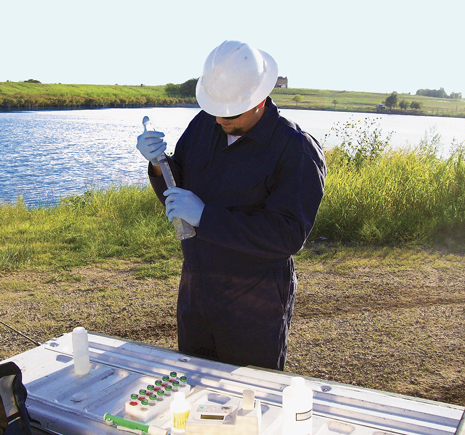 |
| A Baker Hughes employee performs testing for the new Baker Hughes H2prO(tm) water management service that is designed specifically for surface water challenges and provides solutions for technical, economic, and regulatory issues related to oilfield water. Picture courtesy of Baker Hughes. |
|
The successful pilot projects proved that treating and reusing produced and flowback water is a viable option, both technically and economically. The single-step mobile EC treatment was effective in eliminating critical components from the wastewater and the treated water was used to custom-design a borate-cross-linked hydraulic fracturing fluid. Significant environmental and economic benefits also were achieved. 
|
The authors
KUSHAL SETH is Application Lead for Water Management of Baker Hughes. He joined Baker Hughes in 2007 as an applications engineer. Seth holds a master's degree in chemical engineering from Texas Tech University.
BRYANT CORMIER is Operations Project Manager for Water Management of Baker Hughes. He joined Baker Hughes in 2008, bringing his expertise in waste minimization and management, and solids control. Prior to Baker Hughes, Cormier was a team lead for the technical service engineering group of MI SWACO. |
|









